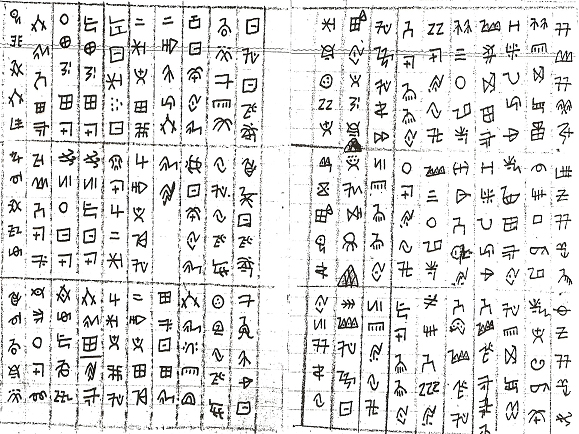Programme de la SEECHAC
Programme des conférences ouvertes aux membres de la SEECHAC pour le premier semestre 2009 :
-
- Le jeudi 29 janvier 2009 :
« Les méditations de la Reine Vaidehî » par Jacques Gies,
Président du Musée National des Arts Asiatiques Guimet. - Le jeudi 26 février 2009 :
« Le chamanisme à écriture Yi, un enjeu politique en Chine »
par Aurélie Névot, Chargée de recherches au CNRS.
- Le jeudi 29 janvier 2009 :
À la différence
des autres pratiques chamaniques répandues dans le monde, les chamanes
yi, appelés bimo ou « maîtres de la psalmodie », opèrent par
le moyen de manuscrits. Bien que les livres soient au fondement des
représentations du monde de leur société « à moitiés » – établie
au Yunnan (Chine) –, il ne s’agit pas ici d’une « religion du
Livre » au sens où l’on emploie ordinairement cette expression, mais
d’une religion de l’écrit. L’écriture en présence, différente
de l’écriture chinoise, a la particularité d’être exclusivement
rituelle, secrète et réservée aux seuls initiés bimo. Nullement
dogmatique, elle assure la communication entre le monde des humains
et celui des esprits. En quoi consiste cette écriture chamanique et
comment s’est-elle transmise au cours des siècles ? Qu’entend-on
par « chamanisme à écriture » ? On proposera de répondre à ces questions
en tenant compte des changements sociaux qui affectent la population
yi : on s’interrogera en particulier sur la dynamique contemporaine
mettant en relation la religion et l’écriture avec le pouvoir dominant.
Car soucieux de maintenir sa tutelle sur les pouvoirs locaux, l’État
chinois s’engage dans un processus d’uniformisation et de laïcisation
des rituels et de l’écriture chamanique qui bouleverse les fondements
politico-religieux de l’ethnie.
Ouvrage
Comme le
sel, je suis le cours de l’eau. Le chamanisme
à écriture des Yi du Yunnan (Chine), Nanterre, Société d’ethnologie,
2008
- Le jeudi 26 mars 2009 :
« A comparison between Nepalese and Bengal sculpture, Pala period »
par Adalbert Gail, Professeur à l’Université Libre de Berlin.Bengal and Nepal stone sculpture
– a comparison from a religous point of viewA comparison of Bengal and
Nepal stone sculpture exhibits close affinities as well as distinct
differences.The Uma-Mahesvara murti is
the most ubiquitous Saiva icon in both areas, while the Ardhanarisvaramurti,
on the other hand, is the rarest one. The high respect towards the individuality
and independence of Devi, the Great Mother, might be an adequate explanation
for that phenomenon.Regarding Vaisnava sculpture
a tripartite group is predominant in both countries: while, however,
Bengal favours a central, four-armed Visnu flanked by Laksmi on his
right and Sarasvati on his left side, Newar art prefers central Visnu
accompanied by Laksmi on his right, yet Garuda on his left side. Here,
the exchange of Garuda by Sarasvati in Bengal can well be interpreted
as a purposeful humiliation of Brahma, who preserved just a marginal
competence as priest and gardien of the zenith. Brahma’s aspect as a
god of creation, in many other Indian areas expressed in the form of
the so called trimurti, is absent both in Bengal and in Nepal;An important specimen in respect
of Hindu sculpture is the image of Surya.In Bengal there is much evidence
of the existence of a particular sect of sun worshippers attested by
a large amount of elaborated images. The adherents of that sect, the
Sauras, called themselves Paramadityas according to inscriptions. Surya
wears boots and – in contrast to Western India – no armour (kancuka),
but an upper garment as many other Indian gods. Surya’s entourage consists
of the traditional acolytes Dandin and Pingala, two wives and two arrow-shooters.
While Surya enjoys hight respect by Hindus as well as by Buddhists in
Nepal a particular Saura sect cannot be proved, as I have pointed out
in a recent article on Sun Worship in Nepal(Pandanus 01, 2008).
The fate of Buddhism
is quite different in both areas. In Bengal Buddhism came to an end
with the Pala and Sena dynasties in 13th century, in Nepal Newar Buddhism
is still alive, yet much assimilated to Hindu ritual and imagery.The early Pala period in Bengal
(750-900 AD) corresponds to the late Licchavi period in the Kathmandu
valley. The figure of the Buddha is more or less similar in both countries,
both continue the Sarnath tradition of the smooth and the Gandhara tradition
of the pleated garment (samghati). Among the Bodhisattvas Avalokitesvara
seems to be the most popular one. In Bengal the most prevalent type
of image is a stela consisting of a flat backside and figures in more
or less high relief. The Hindu stone sculptures have varied forms. The
most prevalent Buddhist stone sculptures in Nepal are
caityas exhibiting the Buddha, the metaphysical Tathagatas,
Bodhisattvas and other divinities.A unique type of image in Nepal
is an octagonal (around 1 m high) stone, the Dharmadhatuvagisvaramandala.
Its upper surface is a round disc covered with figural or symbolical
representations of Buddhist deities. The main figure, however, is Manjusri
or Vagisvara, the mythical creator of the Kathmandu valley.Concluding our short survey
we come back to the beginning: among many masks of Avalokitesvara his
appearance as Halahala-Lokesvara with his Prajna is a magnificent Buddhist
adaptation of the popular Uma-Mahesvara icon in Nepal. - Le jeudi 28 mai 2009 :
« Images chinoises anciennes du Vimalakîrtinirdesa »
par Christine Kontler Barbier, Chargée d’enseignement à l’Université
de Tours et à l’Institut Catholique de Paris.



